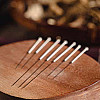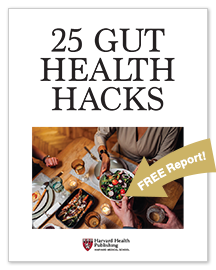
5 timeless habits for better health

What are the symptoms of prostate cancer?

Is your breakfast cereal healthy?

When pain signals an emergency: Symptoms you should never ignore

Does exercise give you energy?

Acupuncture for pain relief: How it works and what to expect

How to avoid jet lag: Tips for staying alert when you travel

Biofeedback therapy: How it works and how it can help relieve pain

Best vitamins and minerals for energy

Should you take probiotics with antibiotics?
Stroke Archive
Articles
Understanding "blood thinners"
These drugs actually help stop dangerous blood clots from forming. Here's when you may need them.
Nearly everyone has heard of "blood thinners." Maybe you or someone you know takes one. But these drugs don't "thin" blood at all.
"They are actually anti-clotting drugs," says Dr. Gregory Piazza, a cardiologist with Harvard-affiliated Brigham and Women's Hospital. "They prevent potentially dangerous blood clots from developing in people at high risk, like those who have atrial fibrillation or a stent in a blood vessel, or who are immobile after surgery."
A little-known factor that boosts heart attack risk
About one in five people has high levels of lipoprotein(a), a fatty particle linked to premature heart disease.
Most people probably haven't heard of lipoprotein(a), although that's not surprising. Cardiologists have known for years that having high levels of these fatty particles circulating in the bloodstream poses a risk to the cardiovascular system. But there wasn't much they could offer in terms of therapy, so widespread testing for lipoprotein(a) — also known as Lp(a) — didn't make sense.
Recent progress means the landscape may soon be shifting. Earlier research showed that injectable cholesterol-lowering drugs known as PCSK9 inhibitors, such as evolocumab (Repatha) or alirocumab (Praluent), may lower Lp(a) by up to 25%. Until last year, however, it wasn't clear whether that reduction actually helped people with high Lp(a).
Fruit of the month: Bananas
Bananas are one of the most popular fruits in the United States, perhaps because they're affordable (about 58 cents per pound, on average) and available year-round.
Among all fruits, bananas are one of best sources of potassium, with about 450 milligrams (mg) per banana. Healthy adults not on certain medications should aim for 4,700 mg of potassium daily, although few Americans meet this goal. A high potassium intake may help reduce high blood pressure and has also been linked to a lower risk of stroke and possibly heart disease.
The major problem of ministrokes
A transient ischemic attack is a warning of a potential full stroke. Don't ignore it.
An estimated 795,000 people get a first-time stroke every year, and there is a good chance they were warned. Transient ischemic attacks (TIAs), also known as ministrokes, share many of the typical stroke symptoms. Yet they often are mild and brief, which is why they routinely get missed or ignored.
"A TIA is your body sounding a loud alarm that you're at high risk for a full stroke, and you need to listen," says Dr. Erica Camargo Faye, a stroke neurologist at Harvard-affiliated Massachusetts General Hospital.
Inflammatory foods and sweet drinks raise heart disease risk
In the journals
Two recent studies shined a new spotlight on how inflammatory foods and drinks can affect heart disease risk. One study, published Nov. 10, 2020, in the Journal of the American College of Cardiology, looked at the impact high- and low-inflammatory diets had among 210,000 people free of heart disease at the beginning of the study. High-inflammatory diets were defined as those with more red, processed, and organ meats; refined carbohydrates; and sweetened drinks. In contrast, anti-inflammatory diets emphasize leafy greens (kale, spinach), dark yellow and orange vegetables (yellow peppers, carrots), whole grains, fruits, tea, coffee, and moderate amounts of red wine.
Participants' eating habits were recorded every four years for up to 32 years. Those who followed a high-inflammatory diet ended up with a 38% higher risk of heart disease and a 28% higher risk of stroke than those who ate a low-inflammatory diet.
Bad habits come in pairs
Your partner's flawed health behaviors may be harming your heart.
It's been said that the longer couples stay together the more they look alike. As it turns out, the resemblance may be more than skin-deep. A study published online Oct. 26, 2020, by JAMA Network Open found that couples' health behavior and heart disease risk factors also look alike — for better or worse.
"We know, even from personal experience, that couples share similar behaviors that can affect health, but it was surprising to find the high levels of shared unhealthy behaviors within couples," says the study's lead author, Dov Shiffman, a senior scientific fellow at the medical testing company Quest Diagnostics.
Googling "chest pain" during the COVID-19 pandemic
Research we're watching
Google searches for "chest pain" spiked in March and April of 2020 during the initial sharp rise in COVID-19 infections, according to a new study. The findings suggest that people were attempting to self-diagnose heart attacks — and may explain why fewer people sought treatment for heart attacks in hospitals during the pandemic.
The study relied on Google Trends, a tool that monitors search term queries over time. The authors looked at searches for "chest pain" and five control terms — "toothache," "abdominal pain," "knee pain," "heart attack," and "stroke" — from January 2017 through May 2020. Searches for chest pain (a common symptom of heart attack but not COVID-19) spiked in states with high rates of COVID-19 infection (New York, New Jersey, and Illinois), while searches for other terms stayed steady.
Get FITT to better fight heart disease
If you've been diagnosed with heart disease, the FITT approach can reduce your risk for heart attack and stroke.
About half of all Americans have at least one of the key risk factors for heart disease, such as high cholesterol, high blood pressure, and excess weight.
You can address those risks with a heart-healthy diet and medications to lower blood pressure and cholesterol levels. But perhaps the biggest boost you can give your heart is regular aerobic exercise.
Artificially sweetened drinks: No heart health advantage?
Research we're watching
Think you're doing your heart a favor by drinking diet instead of regular soda? That may be wishful thinking, according to a research letter published Nov. 3, 2020, in the Journal of the American College of Cardiology.
Researchers studied nearly 105,000 people who filled out three 24-hour dietary recall surveys every six months. During a 10-year follow-up, researchers tracked the participants' cardiovascular health.
Telemonitoring tied to fewer heart attacks, lower medical costs
News briefs
If your doctor or pharmacist offers a service to monitor blood pressure measurements you send from home (called telemonitoring), consider taking advantage of it. Past research has shown that telemonitoring — often paid for by Medicare — may help you reduce your blood pressure. And a study published online Aug. 31, 2020, by Hypertension suggests telemonitoring is also associated with a long-term reduction in heart attacks, strokes, and medical costs. The recent study is a follow-up to a randomized controlled trial from 2013 that divided 450 people into two groups: those who received routine primary care, and those who received a year of telemonitoring services with a pharmacist who helped manage their treatment. People in the telemonitoring group had lower blood pressure for up to two years afterward, compared with people who received routine care. In the recently published follow-up, which followed the same participants for five years, researchers found there were about half as many heart attacks, strokes, and hospitalizations in the telemonitoring group as there were in the group that received routine care. Because there were fewer cardiovascular problems, people in the telemonitoring group also saved an estimated $1,900 each in medical costs.

5 timeless habits for better health

What are the symptoms of prostate cancer?

Is your breakfast cereal healthy?

When pain signals an emergency: Symptoms you should never ignore

Does exercise give you energy?

Acupuncture for pain relief: How it works and what to expect

How to avoid jet lag: Tips for staying alert when you travel

Biofeedback therapy: How it works and how it can help relieve pain

Best vitamins and minerals for energy

Should you take probiotics with antibiotics?
Free Healthbeat Signup
Get the latest in health news delivered to your inbox!
Sign Up











